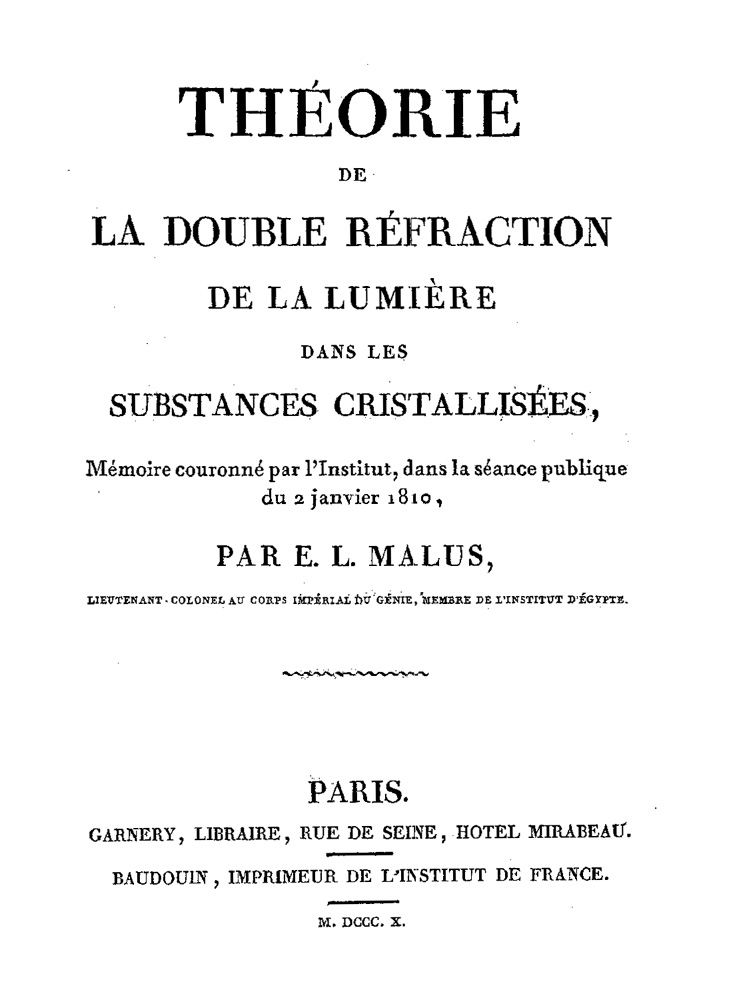MALUS, Étienne Louis.
(1775 – 1812)
Malus was a major of the engineers corp that served under Napolean in his expedition to Egypt and Syria. He was among the first students to recieve a scientific education at the École Polytechnique where he was first introduced to optics. He later taught at the École.
Biographical references: ABF: I 697, 22-34. • Beauchamp, Biographie Moderne, 1816. • DSB: 9, 72-4. • Feller, Biographie Universelle, 1851. • Nouvelle Biographie Générale (Hoefer). • Poggendorff: 2, col. 30. • Schaedler, Biographisch Handwörterbuch, 1891: 76. • WBI.

1. French, 1810.
Théorie | De | La Double Réfraction | De La Lumière | Dans Les Substances Cristallisées, | Mémoire couronné par l'Institut, dans la séance publique | du 2 janvier 1810, | Pare E.L. Malus, | Lieutenant-Colonel Au Corps Impérial Du Génie, Membre De L'Institu D'Égypte. | [wavy rule] | Paris. | Garnery, Libraire, Rue De Seine, Hotel Mirabeau. | [rule] | Baudouin, Imprimeur De L'Institut De France. | [rule] | M. DCCC. X.
4°: [1]-302 p., 3 folding plates (showing diagrams).
Scarce. Enlarged, first edition in book form of a prize winning essay originally published in the Mémoires de Physique et de Chimie de la Société d'Arcueil. In it Malus mathematically describes his discovery of polarization by reflexion, which was a significant event in discovering the optical properties of crystal substances.First edition of this important memoir which contains the author's discovery of polarization of light by reflection. On 4 January 1808, the French Institute "proposed a prize which required an experimental and theoretical explanation of double refraction. The French 'Newtonian' scientists hoped that Malus would find a precise and general law for double refraction within the framework of an emission theory of light. Malus was a skilled mathematician and during 1807 he had carried out experiments on double refraction. By December 1808 Malus had finished his experimental investigations, which verified the Huygenian law. What remained was a theoretical deduction of the law. In January 1809, Laplace published a memoir in which he deduced Huygens' law within the framework of Newtonian mechanics, using the principle of least action, and Malus considered this an insolence which deprived him of the priority. In 1810 Malus won the prize for his 'Théorie de la double réfraction,' published in 1811 [sic]. Here he deduced the law following the same method as Laplace, by means of the principle of least action. Malus won the prize therefore mainly because of his original experimental researches and his discussion of the short-range forces that produce double refraction. Also of great importance was his law for the relative intensities of the ordinary and extraordinary rays."D.S.B., IX, p. 73.
Bibliographical references: BL [536.i.21.]. • Burke, Origins of the Science of Crystals, 1966: 141-2. • DSB: 9, 73. • LKG: X 8. • Mach, Principles of Physical Optics, 1926: 190-4.
.